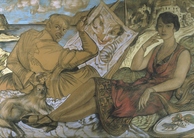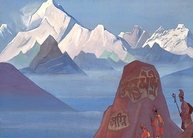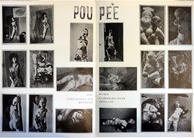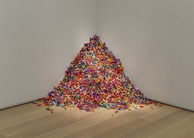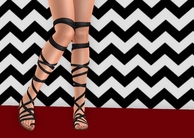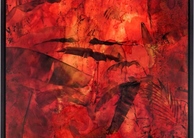Passing Time in The Garden of Earthly Delights by Hieronymus Bosch
By
2014, Vol. 6 No. 03 | pg. 3/3 | « To compliment the expression of sin and overindulgence of the figures, the presence of an overwhelming amount of animals and plants in this panel raises ideas of chaotic and bestial living, rather than domesticated and civilized, living. Instead of controlling and taming the beasts in Imaginary Paradise, the figures all run wild and free alongside (and on top of) many of the creatures, mingling with, eating with, nearly even fornicating with the creatures as if they were equals. Birds sit on top of people’s heads and supply figures with an un-ending supply of fruits. In comparison to the civilized world that humans do live in, the animal kingdom lacks order and self-control. This lack of order and control is present in this panel, as all the figures live as if they too were wild animals. They disregard the existence of a God and a moral code, as they are too busy chasing their earthly desires. The fact that the animals coexist so easily with the figures only emphasizes the lack of civilization and dignity of the humans. In Genesis 1:26, God tells man that he is above animals, and must be in charge of them. From the separation of Adam and Eve and the animals in the first panel, this hierarchy seems apparent. But in the Imaginary Paradise, they seem to no longer realize that humans and animals come from different beginnings and are supposed to conduct themselves differently. Instead, they behave like animals as well, indulging in a careless and fun lifestyle with no concerns of morality and the reasons for why man is meant to distinguish himself from the animal kingdom. It is clear to see through this plethora of sin and disregard that, looking chronologically, there is much more evil in this panel than in either of the previous ones. The figures in Imaginary Paradise seem to not be burdened by Eve’s committing any Original Sin, and yet they still embrace and multiply the sin in their world. This is the middle step between Paradise and Hell. To add to the idea of this being part of a narrative is the idea of remembrance or recognition of a less sinful time prior. In the bottom left-hand corner stands a small group of figures. Most of them do not seem to be paying much attention, off in their own thoughts or carnal pursuits, but there is one figure that seems to be speaking to another one, gesturing off towards the Paradise panel. These two figures indeed seem to be recalling the trio in the previous scene, looking back to the time before any sin had been committed, as if Bosch is trying to tell the viewer that, even in the midst of a sinful life, one can be reminded of sin-free life and turn back to a being virtuous before it is too late. For these figures, there had been evil in the world before them, but it had not run rampant as it is beginning to do in the panel that these two figures exist in. They are in fact recalling the moment of the creation of man and union of Adam and Eve, as can be deduced by their contemplative faces and gesturing towards the left panel (Beagle 50), showing that there is in fact a linear timeline on which these images exist, and that Imaginary Paradise is acknowledged by the figures in it to come chronologically after the left panel. After passing time watching the development of evil in the world, the viewer comes to observe the right panel, Hell. As was previously discussed, this is not Hell in some sort of underworld, but a Hell that occurs in the same location that the Garden previously existed. As Belting writes, “There is no need for the world to wait for Hell. In the hands of humankind, it has already become Hell on earth” (25). People were given a chance to live in a beautiful Paradise, but they still made the mistake of living out their vices, and so the evil that they once embraced has now grown to dominate them, punishing them eternally for pursuing their desires so recklessly. In this panel, the evil is clearly more dominant than in any other panel, for it is the end of the narrative, when evil rules the earth that God designed in the beginning scene. Here, everything that the figures once loved now exercise complete power over them. Many people are made to suffer by musical instruments, a symbol of folly and something that is only used for pleasure. Quite literally, the instruments of pleasure have been turned to instruments of torture, as eerie creatures lead choruses of figures, and other people are strung up on these instruments of both sound and torture (Belting 38). All the gluttons who ate so much of the fruit in Imaginary Paradise are being forever eaten and defecated by a sort of bird-prince in this Hell on earth, and the greedy are vomiting coins into the same hole the gluttons fall in to. A man who foolishly gambled before man’s world fell to the control of sin is now pinned to a card table, game cards askew on the floor. A woman who was vain in her life stares into the backside of a creature, which reflects her own image, while a demon touches her sensually and a toad, representing the Devil, is fastened to her chest. In the tree-man figure, it seems that there is housed a tavern in which gluttons are being eternally served drinks, as the bartender sits glumly on the edge of the tavern. Up above the tree man, sad slouching figures are being lead around in a circle by various animals.The list of punishments in Hell goes on for quite some time, showing in various ways how the “pursuit of sensation becomes in itself a form of punishment” (Beagle 105). There are monstrous human ears, pierced in the center by a large knife, and crushing underneath the ears all the people who blasphemed and lied (108). There are naked soldiers who bear in Hell only their helmets, being pinned down and tortured by animals and demons alike, implying that they sinned under the guise of ‘doing good’ and fulfilling their duty. A figure is pinned to the ground with some sort of dogs chewing his neck out, which could represent his also being a liar or speaking sinful or heretical words. It is clear that the things the figures lusted so much for in the previous scene have now come to overwhelm and control them. The loss of power that mankind has over the evils they once indulged in is evident in their relative size. Where once, in Paradise, the humans were larger than these things, here in Hell people are towered over by the things they pursued in excess. “In the Garden, natural objects were oversized; in hell humans are dwarfed by common man-made articles…and haunted by relics of their earthly vices” (Beagle 106). The instruments used for pleasure, the animals, the foods, all have become threateningly larger than the figures, so much so that they can no longer be enjoyed, but now are only tools of mankind’s suffering. All this symbolism, though it may seem unusually coded to modern viewers, was nothing new or surprising at the time Bosch created this triptych. In the Middle Ages, painters depicted the suffering of the damned in ways that represented symbolically the sins those souls had committed during their lifetime. This would often act as an incentive, a way of teaching the viewers not to sin now, because the afterlife would serve them justice. Bosch’s triptych, while showing the gradual fall of man into sin, can serve this type of incentive purpose as well. Showing how all these figures fall into sin and suffer eternally for it, the viewer will learn not to give in to temptation and overindulgence, or they will suffer the same fate. On images of the damned’s suffering, Paul Binski writes that “Images of this type are hardly subtle, nor were they meant to be…they acted primarily as agents of terror, and so as incentives. Hell’s image naturally exemplified a culture in which retributive notions of justice expressed the community’s outrage at, and denunciation of, crime,” along with other sins (178). Bosch’s Hell indeed represents these “retributive notions of justice” through the various forms of suffering, each soul paying for the lust, gluttony, and other sins committed in the Imaginary Paradise. The overall viewing experience of this triptych is extremely important to how effective the “lesson” of overindulgence, and therefore the image’s power as being incentive for being good in this lifetime, is. The first image, Creation, feels to the viewer like the calm before the storm. The gray and murky waters of the earth, bubbling in its incomplete stage of creation, are safely contained in a transparent orb, so the viewer can watch and contemplate from a safe distance, just as God is doing. The viewer actively participates by opening the panels, revealing the color and business that is to follow in the next three panels. In the Paradise panel, though creatures run throughout and humans exist, there is still a sense of calm, a sense of harmony. The panel is not too busy, and the viewer is not overwhelmed while the eyes travel throughout Paradise. There are smaller details, such as the owl who looks over the figures from the safety of the tower, that take the viewer awhile to notice, like little secrets that with the viewer’s patience will be revealed. Everywhere there is something for the viewer to see for the first time, but this space is far from crowded or chaotic. The next step, however, is both amazing and overwhelming. In Imaginary Paradise, there is so much to look at that at first, one feels as though there is more to take in than one person could ever possibly realize. And indeed, with all the little secret lovers tucked into fruits and people riding around in shells stealing food, it may be so. This panel is by far the most visually crowded, overwhelming, and engulfing. It takes the viewer a good amount of time to feel truly grounded in this image, which at first seems to be a simple scene of people being free and celebrating life. But the more one looks at the details, the more and more uncomfortable the viewer becomes. Things seem off, the figures seem to be doing strange things, such as groping themselves, others, and animals in ways that make the receiver of the action look unhappy. One figure sits glumly atop a bird, and another man has flowers growing out of his orifice, while he crouches with his head on the ground. Others are stuck in uncomfortable-looking positions, or crammed into shells with entirely too many other figures. The more details the viewer notices, once finally able to take a breath, slow down, and delve into the image without feeling overwhelmed, the more disturbing things one begins to see. This scene becomes less and less celebratory and increasingly like some sort of trap. The viewer becomes captured in the scene, one feels increasingly like the figures are trapped in whatever action they are performing. It is as if it was once a merry time, but the merriment has worn away and still they repeat what they do. This sense of deception felt by the viewer upon taking the time to investigate this panel is an important aspect to the triptych’s message of how man falls gradually into sin. Just as the viewer takes time to realize the discomfort of parts of the scene, so man took time to go from merriment to indulgence to overindulgence to being stuck in a cycle of sin, the circle that Augustine mentions the wicked walking in for eternity. Finally, after this chaotic blur of fun and discomfort, the viewer becomes involved in the panel of Hell, the ending to the journey. It is not nearly as chaotic as Imaginary Paradise, nor as misleading. Distinguishable groups of figures suffer against the background of a fiery city and bodies in the distance. The lighter tones of the foreground entice the viewer into the panel where the more individualized punishments occur, and draw the eye back into the darker depths, where figures become part of a swarm of the damned. Unlike the previous panel, there is no gradual realization of the discomfort and suffering of these figures, but rather it is an abrupt turn to infernal punishment. The panel is full of detail and, like Imaginary Paradise, it asks the viewer to look around a good long while. Unlike Imaginary Paradise, there is no deception for the viewer, nor any prompt to recall or reimagine a time of innocence. At this point, the punishment has been decided and set forth, and no amount of regret can change the choices these figures made and the ways in which they behaved. Bosch’s Garden of Earthly Delights is an involved and involving piece that requires time and careful investigation to truly understand and appreciate. Created for Phillip II, the king’s spiritual counselor recognized at the time that Bosch’s work held important “warnings about the eternal dangers that beset the human soul” (Beagle 19). Indeed, the work reveals to all viewers the perils of overindulgence and the thin line between merriment and sin. Bosch used symbolism, scale, and narrative to illustrate this lesson in morality, and he happened to do so in a spectacular piece of artwork that continues to captivate new viewers centuries after its creation. ReferencesBeagle, Peter S. The Garden of Earthly Delights. New York, 1982. Print. Belting, Hans. Hieronymus Bosch: Garden of Earthly Delights. New York, 2002. Print. Binski, Paul. Medieval Death: Ritual and Representation. Ithaca: Cornell University Press, 1996. Blum, Shirley Neilsen. Early Netherlandish Triptychs: A Study in Patronage. California: University of California Press, 1969. Calas, Elena. “Bosch’s Garden of Delights: A Theological Rebus.” Art Journal. 29.2 (1970): 184-199. Web. 20 Feb 2011. Gibson, Walter S. “Bosch’s Dreams: A Response to the Art of Bosch in the Sixteenth Century.” The Art Bulletin. 74.2 (1992): 205-218. Web. 23 Feb 2011. Glum, Peter. “Divine Judgment in Bosch’s Garden of Earthly Delights.” The Art Bulletin. 58.1 (1976): 45-54. Web. 20 Feb 2011. Jacobs, Lynn F. “The Triptychs of Hieronymus Bosch.” The Sixteenth Century Journal. 31.4 (2000): 1009-1041. Web. 23 Feb 2011. Silver, Larry. “God in the Details: Bosch and Judgment(s).” The Art Bulletin. 83.4 (2001): 626-650. Web. 23 Feb 2011. Genesis 1:26. TheHoly Bible:Revised StandardVersion. 16 Apr 2011. Suggested Reading from Inquiries Journal
Inquiries Journal provides undergraduate and graduate students around the world a platform for the wide dissemination of academic work over a range of core disciplines. Representing the work of students from hundreds of institutions around the globe, Inquiries Journal's large database of academic articles is completely free. Learn more | Blog | Submit Latest in Visual Arts |










